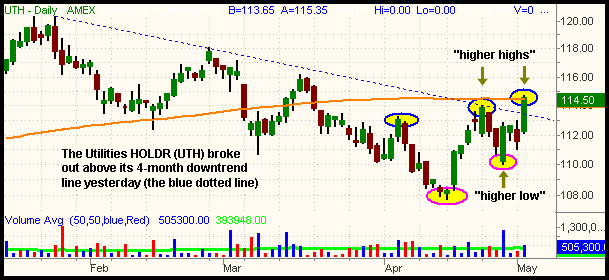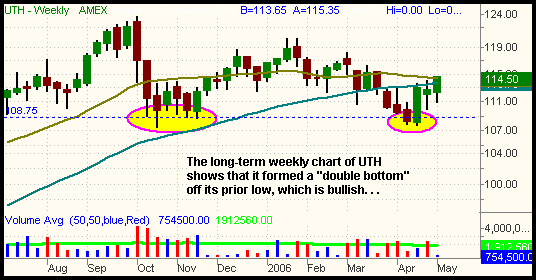The S&P 500 bounced back from Monday afternoon's selloff yesterday, but the Nasdaq Composite lagged behind. Both the S&P and Dow Jones gained 0.6%, wiping out the previous day's losses and then some, but the Nasdaq meandered about in a sideways range before finishing only 0.2% higher. The S&P Midcap 400 Index gained 0.5%, while the small-cap Russell 2000 Index advanced 0.9%. The S&P, Nasdaq, and Dow each had "inside days," meaning that their intraday trading ranges were completely contained within their respective ranges of the previous day. Such "inside days" often occur during price consolidations, but they don't mean much when the major indices are stuck in a choppy trading range.
Total volume in both the NYSE and Nasdaq was about the same as the previous day's levels, falling less than 1% in both exchanges. Again, turnover exceeded average levels, hinting at a bit of "churning" near the highs. If the broad market was trading at new highs, the volume increases over the past two weeks would be positive, but the major indices have yet to breakout and hold. Market internals were positive in the NYSE, as advancing volume exceeded declining volume by a margin of 2 to 1, but the Nasdaq's ratio was only positive by a nominal ratio.
One industry that made a stealth move underneath the surface of yesterday's lethargic session was the Dow Jones Utilities Average ($DJU), which zoomed 2.4% higher and broke out above resistance of its four-month downtrend line. The two most popular ETFs that track the Utilities sector are the Utilities HOLDR (UTH) and the S&P Select Utilities SPDR (XLU). Of the two, the chart pattern in UTH has followed the trend of the actual sector index the closest. Looking at the daily chart of UTH below, notice how it not only broke out above its downtrend line (the dotted blue line), but also has formed two "higher highs" and one "higher low:"

The "higher highs" and "higher low," combined with the break of the daily downtrend line, tell us that UTH has broken its downtrend and may be in the process of starting a new uptrend. The long-term weekly chart also shows that UTH formed a "double bottom" in the middle of last month, which further adds to the bullish technical picture:

The only negative with this setup is that UTH closed right at resistance of its 200-day moving average. However, we don't think it is a big problem because the weekly "double bottom" and break of the downtrend line should be more significant. Regardless, we will wait for confirmation of a breakout above the 200-day MA before buying UTH. Regular subscribers will see the trigger, stop, and target prices below. We also continue to stalk the Regional Bank HOLDR (RKH) for potential long entry over yesterday's high.
On the downside, the Biotech Index ($BTK) broke down and closed firmly below its 200-day moving average yesterday. We initially pointed out the relative weakness in this sector several weeks ago, but it has since been totally devoid of any buying interest. Because the year-long uptrend in that sector has clearly been broken, both the Biotech HOLDR (BBH) and iShares Nasdaq Biotech (IBB) can be sold short on bounces into resistance. We also are stalking the Oil Index ($XOI), not to be confused with the stronger Oil Services Index ($OSX), for potential short entries. There is no confirmation yet, but we are waiting to see if the index forms a "lower high" on its daily chart, which seems likely considering that many of the stocks in that sector have bounced on much lighter volume than they sold off last week. If we see a "lower high" shaping up, we will look for short setups in that sector, but the signal to sell short has not yet presented itself.
Both the S&P and Dow technically closed yesterday at new multi-year highs, but failed to break out above their previous intraday highs from last month. Undoubtedly, relative weakness in the Nasdaq has been preventing both indices from breaking out of their ranges. For the second consecutive day, the Nasdaq Composite closed below its 50-day moving average, but above support of its prior low from April 17. That same support level of 2,300, which we illustrated yesterday, is an important area to watch going into today. With the Nasdaq weighing so heavily on the broad market, you probably want to avoid long positions in the tech arena. Instead, consider buying breakouts in the Utilities and Banking sectors, two of the strongest sectors in the market right now.
Deron Wagner is the Founder and Head Trader of both Morpheus Capital LP, a U.S. hedge fund, and Morpheus Trading Group, a trader education firm launched in 2001 that provides daily technical analysis of the leading ETFs and stocks. For a free trial to the full version of The Wagner Daily or to learn about Wagner's other services, visit MorpheusTrading.com or send an e-mail to deron@morpheustrading.com.